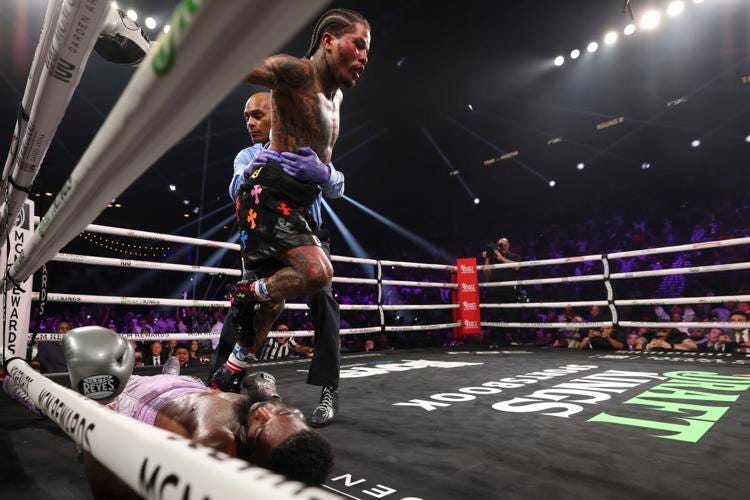Gervonta Davis vs Frank Martin: Tactics vs Strategy
With his crushing win over Frank Martin, WBA lightweight champion Gervonta Davis demonstrated the importance of a good gameplan.
Author’s note: You may have noticed a lag in articles this month. Due to a few issues, some technical and some personal, I have been sitting on a few half-finished articles for a minute now. The good news is, you will have a glut of pieces to enjoy before the end of June. I’ll have a long-delayed breakdown of Makhahev-Poirier coming later this week, but first: something a little more timely. I hope you enjoy it, and thank you for your patience!
The best fight of June 15th did take place in Las Vegas, but far from the dreary, corrugated walls of the UFC Apex. It was a boxing match: lightweight knockout machine Gervonta Davis defending against undefeated prospect Frank Martin. Southpaws have a reputation of having terrible fights with other southpaws, but in this case the two lefties delivered a classic style clash with an unforgettably violent finale.
Frank Martin managed to poke some holes in Davis’ vaunted defense early on, surprising him with the lead hand and pulling him into more than one sharp counter left, all while flying lithely around the ring. In that sense, Martin delivered an excellent performance.
In another sense, it was a fight that Martin was losing the entire time, even if it took a while for him to realize it.
The difference was conceptual. Tactics versus strategy—or rather, tactics without strategy versus tactics within strategy. Frank Martin enjoyed many tactical victories last weekend, but, strategically, Gervonta Davis had his number from the outset. When Davis finally produced a climactic KO in round 8—his 29th as a pro—it felt as though the fight couldn’t have ended any other way.
A bag of tricks
Let’s start with some basic definitions. The terms “tactics” and “strategy” are often used interchangeably, but they describe completely different concepts.
Tactics are the basic building blocks of a fight. If individual moves—jabs, hooks, slips, sidesteps—are a fighter’s raw materials, then tactics are the ideas that give them shape and purpose. A slip is a move; a slip setting up a counter punch is a tactic. Tactics may be simple and straightforward, as in the previous example, or they may be subtle and complex.
Strategy, on the other hand, is the blueprint that turns those building blocks into a usable structure. If tactics answer the question, “How?”—as in, “how do I counter the right hand?” or “how do I trap my opponent in the corner?”—then strategy addresses the larger question: “Why?” Why do anything in a fight, after all, unless it fits the bigger picture? All tactics are viable in a vacuum, but strategy makes the distinction between those that serve the goal and those that don’t. You can beat an opponent with tactics alone, but only strategy allows you to control the outcome.
Now, to be clear, I am not saying that Frank Martin entered the ring the other night with no strategy at all in mind. He did have a plan, and a more experienced fighter might have executed that plan successfully. For Martin, however, the strategy was no good. Speaking about the fight after the fact, he didn’t even seem to know what exactly went wrong, saying something along the lines of “I was doing good and then I wasn’t.”
But before we let the analysis run Frank Martin over just like Gervonta Davis did, I want to highlight some of his good work. It’s no easy task to fight a world champion with nearly twice as many fights under his shiny gold belt. This was a learning experience for Martin, and he had plenty of successes on which to build a better version of himself down the road.
One thing Martin did particularly well was to use his jab to improve his own position and keep Davis at bay. Mechanically speaking, Martin’s southpaw jab worked exactly the same against Davis as an orthodox jab would against another righty. And being a southpaw himself, Davis doesn’t have a lot of experience dealing with the easy, open lines afforded to the jab in a closed stance matchup. It took some time for him to adjust his usual, shoulder-rolling defense to Martin’s speedy right hand.
First we see Martin using his jab to get out of a tight spot. As Davis walks him into the ropes, Martin lowers his base (generally a good idea whether attacking or defending) and meets Davis on the way in with a triple jab. See how he takes small steps to gain space while Davis is occupied with the jabs. He first steps forward, wedging his right foot into Davis’ stance. A former wrestler, Frank Martin might well think of this as a penetration step, but where a wrestler would use that move to slingshot himself into the opponent, here the foot is a wedge which he uses to pivot. In fact, he makes a series of small pivots, always stepping with the jab. Without that active lead hand all this nifty footwork would simply get punished. The jab forces Davis to react defensively, buying Martin the tempo he needs to move his feet safely.
Keep reading with a 7-day free trial
Subscribe to The Finer Points of Face Punching to keep reading this post and get 7 days of free access to the full post archives.





